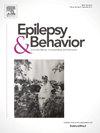影响癫痫儿童及其照顾者生活质量的危险因素:日本横断面在线调查的二次分析。
IF 2.3
3区 医学
Q2 BEHAVIORAL SCIENCES
引用次数: 0
摘要
目的:本研究旨在通过对日本横断面在线调查的二次分析,评估癫痫儿童及其照顾者的生活质量(QOL),以及照顾者的负担。结果:在2023年3月至2023年5月期间,1147名照顾者完成了调查。大多数照顾者(n = 1144, 99.7%)为父母。QOLCE-Js52评分的平均值(标准差[SD])为68.3分(14.2分)。SF-8的PCS和MCS的平均(SD)分数分别为46.5(4.5)和43.7(5.1),显著低于日本普通人群(p结论:危险因素,如紧急运输,可以通过非医院环境中的抢救药物减轻。本文章由计算机程序翻译,如有差异,请以英文原文为准。
Risk factors affecting quality of life in children with epilepsy and their caregivers: A secondary analysis of a cross-sectional online survey in Japan
Objective
This study aimed to evaluate the quality of life (QOL) in children with epilepsy and their caregivers, as well as the caregiver burden, through a secondary analysis of a cross-sectional online survey in Japan.
Methods
Eligible participants were caregivers of children (aged < 18 years) diagnosed with epilepsy. Children’s QOL was measured using the daily living subset of the Japanese version of the Quality of Life in Children with Epilepsy (QOLCE-Js52). Caregiver QOL and burden were measured using the physical component summary (PCS) and mental component summary (MCS) of the Short Form-8 (SF-8) and the short Japanese version of the Zarit Caregiver Burden Interview (J-ZBI_8).
Results
Between March 2023 and May 2023, 1,147 caregivers completed the survey. Most caregivers (n = 1,144, 99.7 %) were parents. The mean (standard deviation [SD]) QOLCE-Js52 score was 68.3 (14.2). The mean (SD) scores of the PCS and MCS of the SF-8 were 46.5 (4.5) and 43.7 (5.1), respectively, which were significantly lower than those of the general Japanese population (p < 0.001 for both means). The mean (SD) J-ZBI_8 score was 4.9 (7.1), with 13.2 % of caregivers scoring at least 13, a predictor of depression. Multivariable regression analysis showed that disability was a significant risk factor for lower QOL and increased caregiver burden (p < 0.001). Frequent seizures, emergency transportation, and longer epilepsy duration were associated with poorer QOL in children and caregivers.
Conclusion
Risk factors, such as emergency transport, may be mitigated by rescue medication in non-hospital settings.
求助全文
通过发布文献求助,成功后即可免费获取论文全文。
去求助
来源期刊

Epilepsy & Behavior
医学-行为科学
CiteScore
5.40
自引率
15.40%
发文量
385
审稿时长
43 days
期刊介绍:
Epilepsy & Behavior is the fastest-growing international journal uniquely devoted to the rapid dissemination of the most current information available on the behavioral aspects of seizures and epilepsy.
Epilepsy & Behavior presents original peer-reviewed articles based on laboratory and clinical research. Topics are drawn from a variety of fields, including clinical neurology, neurosurgery, neuropsychiatry, neuropsychology, neurophysiology, neuropharmacology, and neuroimaging.
From September 2012 Epilepsy & Behavior stopped accepting Case Reports for publication in the journal. From this date authors who submit to Epilepsy & Behavior will be offered a transfer or asked to resubmit their Case Reports to its new sister journal, Epilepsy & Behavior Case Reports.
 求助内容:
求助内容: 应助结果提醒方式:
应助结果提醒方式:


